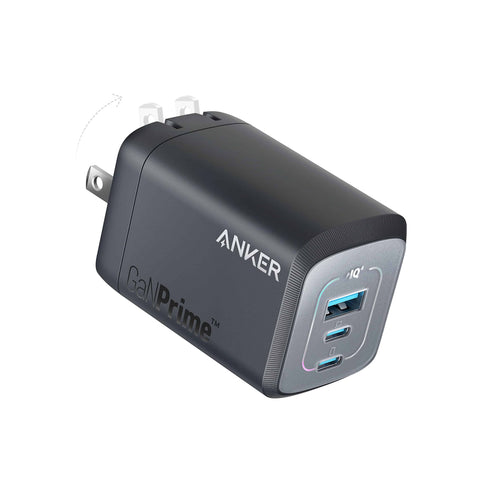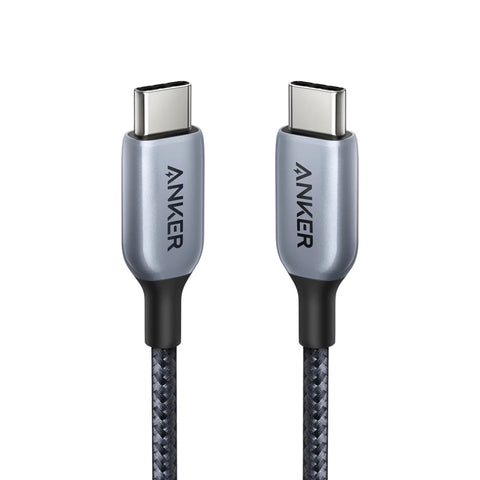
The Transition to Convenience: Does Apple Use USB-C?
Share
Delving deep into Apple's strategy for hardware connectivity and power supply, we explore an intriguing question—does Apple use USB-C? With a past favoring the exclusive, proprietary Lightning connector, Apple's recent maneuver towards the increasingly universal USB-C across some of their products sparks interest and raises queries. This article will plunge into understanding why Lightning once overshadowed USB-C, pinpoint Apple devices currently supporting USB-C charging, and enumerate the advantages of USB-C over Lightning.

Why Did Apple Use Lightning Instead of USB-C in the Past?
The use of Lightning over USB-C in Apple's past devices was primarily for two reasons: control and consistency.
The Lightning connector, introduced in 2012 with the iPhone 5, was exclusively developed by Apple, affording them a high degree of control. With manufacturing, specification, and compatibility all under the same roof, Apple had the ability to tightly integrate their hardware and software. This fit with their broader philosophy of controlling the environment in which their products operate. Furthermore, it allowed Apple to impose licensing fees on accessory makers as part of its Made for iPod/iPhone/iPad (MFi) program, bringing additional revenue.
Consistency and user experience have always been a priority for Apple. When Lightning was introduced, micro-USB (the prevalent non-Apple standard at the time) could not offer the same user-friendly experience. The Lightning cable was reversible, substantially thinner and offered better power management, making it superior to micro-USB. USB-C, a connector that could match Lightning's advantages, was not standardized until 2014.
Apple Devices That Support USB-C Charging
Here is a more detailed overview of the Apple devices that are compatible with USB-C charging:
MacBooks
The transition of MacBooks to USB-C began in 2015 with the 12-inch MacBook and expanded across the line over subsequent years. The switch allowed Apple to leverage USB-C's power delivery capability, delivering up to 100W. At the same time, the universal port also supports high-speed data transfer and video output, making it a truly versatile connector.
iPads
The iPad Pro made the switch to USB-C, starting with the 3rd generation model launched in 2018. The USB-C port on these models serves multiple purposes, from charging the device, to connecting peripherals, to supporting external displays. By adopting USB-C, Apple sought to align the iPad Pro more closely with its MacBook line, bolstering its status as a device that can handle professional-grade tasks.
Apple Pro Display
Apple's Pro Display XDR, introduced in 2019, also utilizes a USB-C port – specifically, a Thunderbolt 3 port, which has the USB-C form factor. Thunderbolt 3, developed by Intel in collaboration with Apple, offers data transfer speeds far surpassing typical USB-C ports. The Pro Display XDR can therefore handle not only power delivery but also high-resolution video data from a connected Mac.
iPhone 15
Does iPhone have USB-C? Apple's iPhone 15 series has transitioned from Lightning to USB-C. After 11 years of the Lightning port, the change is finally coming to reality, which is iPhone USB-C. Reasons for this include growing pressure from regulatory bodies to adopt a universal standard, the increased capability of USB-C to support a wider range of accessories and faster data transfer speeds. A switch in this direction means that users will no longer require different cables for their Apple devices—a move that aligns with Apple's pursuit of a simplified user experience.
Advantages of USB-C over Lightning
Despite the effectiveness of Lightning connectors, there are numerous benefits of USB-C that could justify its broader implementation across Apple's product lineup.
Universal Compatibility: Unlike the proprietary Lightning connector, USB-C offers universal compatibility. This is a significant advantage in the tech world, where several devices and accessories built by different manufacturers need to interact.
Power Delivery: USB-C has a high power output capability, which can reach up to 100W. This capability allows devices to charge faster and can power larger devices.
Versatility: Being a multi-use port, USB-C can be used for multiple purposes, including charging devices, transferring data, and transmitting video output through a single cable.
Future-Proof: As technology evolves, the move to USB-C can be seen as future-proofing Apple's device range. Moreover, with the USB-C standard being updated continuously, the connector can support new technologies as they emerge.
Upgrade your charging experience with Anker's USB-C charger collection:
Anker Prime 100W GaN Wall charger
The Anker Prime 100W GaN Wall charger offers high-speed charging for three devices simultaneously—be it a phone, tablet, or notebook—via 2 USB-C and 1 USB-A ports, from a singular power source. Regardless of the port combination used, it provides an efficient 100W max output. Its ultra-compact design, about 43% smaller than a regular 96W MacBook charger, makes it conveniently portable. Furthermore, the built-in ActiveShield™ 2.0 safety system guarantees secure charging, allowing you to energize your devices worry-free.
{{ component: "product", handle: "a2343-100w-usb-c-charger", sku: "A2343111"}}
Anker 765 USB-C to usb-c cable
Introducing the Anker 765 USB-C to USB-C Cable, backed by Anker's innovative technology and 80 million+ strong customer base. Experience high-speed charging up to 140W using USB Power Delivery 3.1, compatible with many devices including phones, laptops, and tablets. Its universal design caters to all USB-C devices and boasts a durable construction that withstands a 35,000-bend lifespan, ensuring reliability in your everyday use.
{{ component: "product", handle: "a8866", sku: "A88660A1"}}
Conclusion
To conclude, the question, "does Apple use USB-C," has become increasingly relevant as we witness the shift from Lightning to USB-C in Apple devices. This change embraces a future where convenience, compatibility, and high-speed performance are the standard. As technology evolves and demands grow, Apple users can confidently look forward to a more unified and efficient technological landscape under the dominance of USB-C. Will you be ready for the change?
FAQ
Here are some commonly asked questions about ‘does Apple use USB-C’.
Are all MacBooks equipped with USB-C ports?
Yes, all modern MacBooks are equipped with USB-C ports. Apple began integrating this port type in 2015 with the MacBook and since 2016 with the MacBook Pro line. USB-C allows versatile use, including data transfer, device charging, and video output, offering a one-size-fits-all port solution on Apple's laptops.
How fast can you charge with iPhone 15 USB-C chargers?
Do iPhones use USB-C? Now, with the iPhone 15 having USB-C chargers, you can expect faster charging speeds compared to previous generations. The new iPhone 15 models are said to support charging up to 35W, a significant improvement over the 27W charging capability of the iPhone 14 Pro. This transition from Lightning to USB-C could potentially reduce charging times, and the USB-C innovation aligns with Apple's overall move toward providing a more efficient and versatile charging experience.
What is the future of USB-C in the Apple ecosystem?
The future of USB-C in the Apple ecosystem looks promising as the company continues to transition from Lightning to USB-C for its devices. This shift, as seen with the iPhone 15, will eventually make USB-C the standard for charging and data transfer across Apple's product range, improving compatibility, convenience, and charging speeds for users.